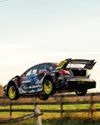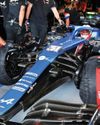
IndyCar’s new Aeroscreen will be underclose scrutiny this year as it makes its race debut, but the extraordinary device has already been extensively tested and both organisers and manufacturers are confident it will pass muster on track.
The device is made up of a 3D printed titanium framework designed by Red Bull Advanced Technologies (RBAT) and built by Austrian company Pankl. The screen is developed by PPG and is designed to protect the driver against small part intrusion into the cockpit.
However, the tube structure on which the polycarbonate is mounted is a work of art. Weighing just 12.25kg (27lb), the titanium top bar is made from five 3D printed pieces welded together in a form that resembles the Halo safety device that has been widely adopted in FIA-sanctioned racing.
Several manufacturing methods were considered in the first instance as the development cycle began. The initial design was made for titanium casting (Ti-casting), but it became apparent that the timeline to produce the volume of Aeroscreens needed for the first race of 2020 was too tight to use that method. 3D printing then became the most feasible option and Pankl, as a well-known racing industry tier-one supplier, became the chosen partner for industrialisation.
The Aeroscreen assembly consists of four sub-systems: carbon fiber frame bonded onto the chassis; top frame (the 3D printed structure); polycarbonate screen and an aero fairing. IndyCar is the first race series in the world to use additive manufacturing (AM) technology to produce a safety-critical system on its cars, so there is a great deal of interest in how the technology stands up to scrutiny.
This story is from the July 2020 edition of Racecar Engineering.
Start your 7-day Magzter GOLD free trial to access thousands of curated premium stories, and 8,500+ magazines and newspapers.
Already a subscriber ? Sign In
This story is from the July 2020 edition of Racecar Engineering.
Start your 7-day Magzter GOLD free trial to access thousands of curated premium stories, and 8,500+ magazines and newspapers.
Already a subscriber? Sign In
Talk the torque
More thoughts on in-wheel motors and their effects on twisting force
Rolling about
An explanation of the limitations of a previous load transfer article, bringing jacking forces into the mix
F1 breaks schedule records
The FIA has confirmed no fewer than 23 races on the 2022 Formula 1 World Championship schedule, the highest number of grands prix ever to be held in a single season, and that has led to criticism from some teams that will be on the road for eight months.

Under pressure
Toyota may have finished first and second at Le Mans this year, but the effort required to overcome a fuel delivery problem and finish with both cars was Herculean
Physics at work
Dutch company, Intrax, offers Racecar Engineering an insight into the technologies it employs to optimise its suspension products
Williams' 2030 ambition
Williams Racing has committed to becoming climate positive by 2030 as part of an all-new sustainability strategy.
Diff'rent strokes
Racecar looks at the different types of mechanical differential, their benefits and limitations
Das Boot
A curious Twitter exchange fired up a unique, hydrogen-powered, cross-country project that will contest the Baja 1000 in November 2022

Air born
Every racecar engineer's dream is a blank sheet of paper design. When Hoonigan and Subaru approached Vermont Sportscars about building the next generation of Gymkhana racer, that's just what the company was given

Remote control
Called variously ‘virtual garages’, ‘mission control’ or ‘race support rooms’ is the future of race engineering sitting in the warm back at HQ?